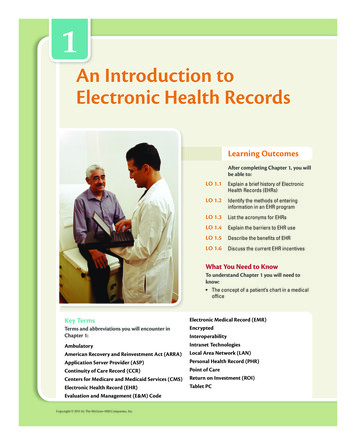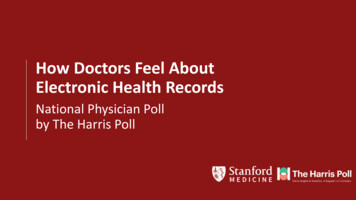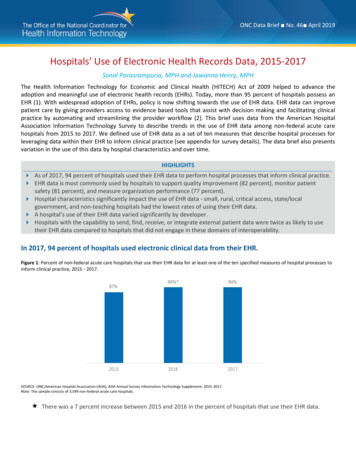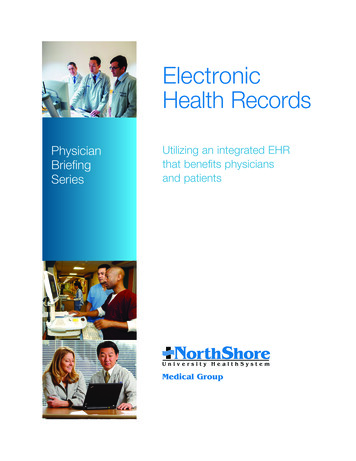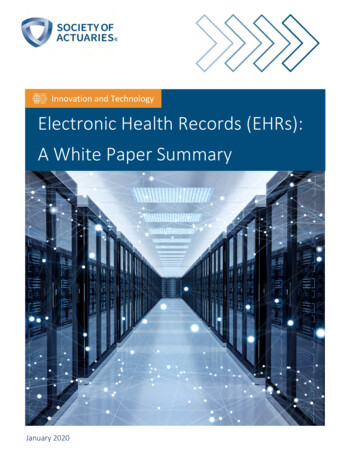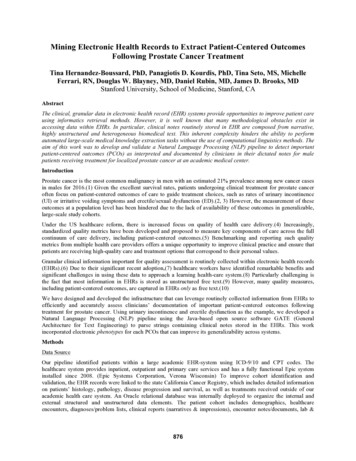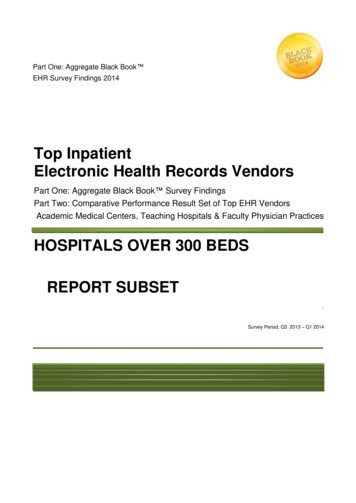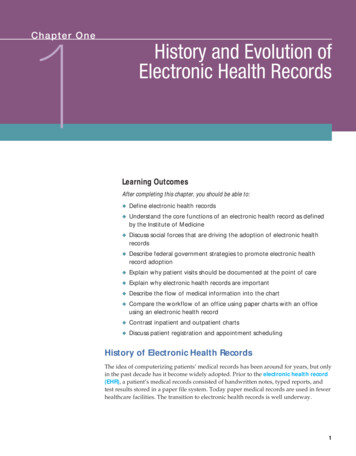
Transcription
1Ch ap ter OneHistory and Evolution ofElectronic Health RecordsLearning OutcomesAfter completing this chapter, you should be able to: Define electronic health records Understand the core functions of an electronic health record as definedby the Institute of Medicine Discuss social forces that are driving the adoption of electronic healthrecords Describe federal government strategies to promote electronic healthrecord adoption Explain why patient visits should be documented at the point of care Explain why electronic health records are important Describe the flow of medical information into the chart Compare the workflow of an office using paper charts with an officeusing an electronic health record Contrast inpatient and outpatient charts Discuss patient registration and appointment schedulingHistory of Electronic Health RecordsThe idea of computerizing patients’ medical records has been around for years, but onlyin the past decade has it become widely adopted. Prior to the electronic health record(EHR), a patient’s medical records consisted of handwritten notes, typed reports, andtest results stored in a paper file system. Today paper medical records are used in fewerhealthcare facilities. The transition to electronic health records is well underway.1
Institute of Medicine (IOM)Beginning in 1991, the IOM (a division of the National Academies of Sciences, Engineering, and Medicine) sponsored studies and created reports that led the way toward theconcepts we have in place today for electronic health records. Originally, the IOM calledthem computer-based patient records.1 During their evolution, EHRs have had many othernames, including electronic medical records, computerized medical records, longitudinal patientrecords, and electronic charts. All of these names referred to something intended to replacethe paper chart. In 2003, the IOM chose the name electronic health records, or EHR, because“health” means “a state of well-being,” and the goal of computerizing medical records isto improve the delivery of safe, quality care focused on patients’ health.The IOM report2 put forth a set of eight core functions that an EHR should be capable ofperforming. The influence this report had on the development of EHR cannot be overstated. The eight core functions listed here became determining factors in the evolution ofEHR, and the ability to perform these functions is the criteria by which EHRs are judged.The eight core functions are as follows:Health information and data This function provides a defined data set that includessuch items as medical and nursing diagnoses, a medication list, allergies, demographics,clinical narratives, and laboratory test results. Further, it provides improved access toinformation needed by care providers when they need it.Result management Computerized results can be accessed more easily (than paperreports) by the provider at the time and place they are needed. Reduced lag time allows for quicker recognition and treatment of medical problems. The automated display of previous test results makes it possible to reduce redundantand additional testing. Having electronic results can allow for better interpretation and for easier detectionof abnormalities, thereby ensuring appropriate follow-up. Access to electronic consults and patient consents can establish critical links andimprove care coordination among multiple providers, as well as between providerand patient.Order management Computerized provider order entry (CPOE) systems canimprove workflow processes by eliminating lost orders and ambiguities caused by illegible handwriting, generating related orders automatically, monitoring for duplicateorders, and reducing the time required to fill orders. CPOE systems for medications reduce the number of errors in medication dose andfrequency, drug allergies, and drug–drug interactions. The use of CPOE, in conjunction with an EHR, also improves clinician productivity.Decision support Computerized decision support systems include prevention, prescribing of drugs, diagnosis and management, and detection of adverse events and disease outbreaks. Computer reminders and prompts improve preventive practices in areas such as vacci-nations, breast cancer screening, colorectal screening, and cardiovascular risk reduction.1R. S. Dick and E. B. Steen, The Computer-based Patient Record: An Essential Technology for Health Care(Washington, DC: Institute of Medicine, National Academy Press, 1991, revised 1997, 2000).2Ibid.2Chapter 1 History and Evolution of Electronic Health Records
Electronic communication and connectivity Electronic communication among carepartners can enhance patient safety and quality of care, especially for patients who havemultiple providers in multiple settings that must coordinate care plans. Electronic connectivity is essential in creating and populating EHR systems with datafrom laboratory, pharmacy, radiology, and other providers. Secure e-mail and web messaging have been shown to be effective in facilitating com-munication both among providers and with patients, thus allowing for greater continuity of care and more timely interventions. Automatic alerts to providers regarding abnormal laboratory results reduce the timeuntil an appropriate treatment is ordered. Electronic communication is fundamental to the creation of an integrated healthrecord, both within a setting and across settings and institutions.Patient support Computer-based patient education has been found to be successful inimproving control of chronic illnesses, such as diabetes, in primary care. Examples of home monitoring by patients using electronic devices include self-testing by patients with asthma (spirometry), glucose monitors for patients withdiabetes, and Holter monitors for patients with heart conditions. Data from monitoring devices can be merged into the EHR, as shown in Figure 1-1.Courtesy of Javier Larrea/age fotostock/Getty ImagesFigure 1-1 Data from the digital spirometer transfers to the EHR.Administrative processes and reporting Electronic scheduling systems increase theefficiency of healthcare organizations and provide better, timelier service to patients. Communication and content standards are important in the billing and claims man-agement area. Electronic authorization and prior approvals can eliminate delays and confusion;immediate validation of insurance eligibility results in more timely payments andless paperwork.Chapter 1 History and Evolution of Electronic Health Records3
EHR data can be analyzed to identify patients who are potentially eligible for clinicaltrials, as well as candidates for chronic disease management programs. Reporting tools support drug recalls.Reporting and population health Public- and private-sector reporting requirements atthe federal, state, and local levels for patient safety and quality, as well as for publichealth, are more easily met with computerized data because it eliminates the labor-intensive and time-consuming abstraction of data from paperrecords and the errors that often occur in a manual process. facilitates the reporting of key quality indicators used for the internal qualityimprovement efforts of many healthcare organizations. improves public health surveillance and timely reporting of adverse reactions anddisease outbreaks.Later in this chapter, we will discuss initiatives by the U.S. government to encouragethe development of healthcare information technology. The IOM definitions of corefunctions influenced and were adapted into the strategic framework developed by thegovernment. Subsequent chapters will refer back to these eight core functions as youlearn to use the EHR functionality that evolved to meet them.Computer-based Patient Record Institute (CPRI)Another early contributor to the thinking on EHR systems was the Computer-basedPatient Record Institute (CPRI), which identified three key criteria for an EHR: Capture data at the point of care Integrate data from multiple sources Provide decision supportHealth Insurance Portability and Accountability Act (HIPAA)The Health Insurance Portability and Accountability Act (HIPAA), which will becovered in Chapter 11, did not define an EHR, but perhaps the HIPAA Security Rulebroadened the definition. The Security Rule established protection for all personallyidentifiable health information stored in electronic format. Thus, everything about apatient stored in a healthcare provider’s system is protected and treated as part of thepatient’s EHR. HIPAA also standardized transaction formats for several AdministrativeProcesses identified in the IOM report.EHR DefinedIn Electronic Health Records: Changing the Vision, authors Murphy, Waters, Hanken, andPfeiffer define the EHR to include “any information relating to the past, present or futurephysical/mental health, or condition of an individual which resides in electronic system(s) used to capture, transmit, receive, store, retrieve, link and manipulate multimediadata for the primary purpose of providing healthcare and health-related services.”3The core functions defined by the IOM and CPRI suggest that the EHR is not just whatdata is stored, but what can be done with it. In the broadest sense, Electronic HealthRecords are the portions of a patient’s medical records that are stored in a computer system as3Gretchen Murphy, Kathleen Waters, Mary A. Hanken, and Maureen Pfeiffer, eds., Electronic Health Records:Changing the Vision (Philadelphia: W. B. Saunders Company, 1999), 5.4Chapter 1 History and Evolution of Electronic Health Records
well as the functional benefits derived from having an electronic health record. EHRs focus onand promote the total health of the patient.Social Forces Driving EHR AdoptionVisionary leaders in medical informatics had been making the case for the EHR for along time. However, the combination of several important reports caught the public’sattention and set in motion economic and political forces that drove the transformationof our medical records systems.Health SafetyThe IOM published a report that stated the following: “Healthcare in the United Statesis not as safe as it should be—and can be. At least 44,000 people, and perhaps as manyas 98,000 people, die in hospitals each year as a result of medical errors that could havebeen prevented, according to estimates from two major studies.“Beyond their cost in human lives, preventable medical errors exact other significanttolls. They have been estimated to result in total costs (including the expense of additional care necessitated by the errors, lost income and household productivity, and disability) of between 17 billion and 29 billion per year in hospitals nationwide. Errorsalso are costly in terms of loss of trust in the healthcare system by patients and diminished satisfaction by both patients and health professionals.“A variety of factors have contributed to the nation’s epidemic of medical errors. Oneoft-cited problem arises from the decentralized and fragmented nature of the healthcaredelivery system—or ‘non-system,’ to some observers. When patients see multiple providers in different settings, none of whom has access to complete information, itbecomes easier for things to go wrong.”4Over a decade later, the IOM reported5 medical errors still occurring routinely, citing astudy of 10 North Carolina hospitals over a 5-year period that found approximately 18percent of patients were harmed by medical care, with 63 percent of those cases beingjudged as preventable. These findings were reinforced by a nationwide study revealingthat one in seven Medicare patients suffered harm from hospital care, with an additional one in seven suffering temporary harm from care-related problems that weredetected in time and corrected; 44 percent of these errors were found to be preventable.In the report conclusion, the IOM committee recommended ten actions to achieve thebest care at lower costs. Five of them involving EHR were: Improve the digital infrastructure capacity to capture clinical, care delivery process,and financial data, Streamline and revise research regulations to improve care, promote the capture ofclinical data, and generate knowledge. Accelerate integration of the best clinical knowledge into care decisions throughclinical decision support.4Linda T. Kohn, Janet M. Corrigan, and Molla S. Donaldson, eds., To Err Is Human: Building a Safer Health System(Washington, DC: Committee on Quality of Healthcare in America, Institute of Medicine, 1999).5Mark Smith, Robert Saunders, Leigh Stuckhardt, and J. Michael McGinnis, eds., Best Care at Lower Cost: The Pathto Continuously Learning Health Care in America (Washington, DC: Committee on the Learning Health CareSystem in America, The National Academies Press, 2012).Chapter 1 History and Evolution of Electronic Health Records5
Offer patient-centered care involving patients and families in decisions regardinghealth and health care, tailored to fit their preferences. Improve continuity of care by coordination and communication within and acrossorganizations.Health CostsThe 1999 IOM report got the attention of the press and public. It also got the attention of150 of the nation’s largest employers who sponsored employee health insurance programs and had become frustrated by the increasing costs of health insurance benefitsfor which they had little or no say about the quality of care. Following the release of theIOM report, these employers formed the Leapfrog group.A study by the Center for Information Technology Leadership found more than 130,000life-threatening situations caused by adverse drug reactions alone. The study suggestedthat 44 billion could be saved annually by installing computerized physician orderentry systems in ambulatory settings.Leapfrog created a strategy that tied purchase of group health insurance benefits toquality care standards. It also promoted computerized provider order entry (CPOE) as amea
History of Electronic Health Records The idea of computerizing patients’ medical records has been around for years, but only in the past decade has it become widely adopted. Prior to the electronic health record (EHR), a patient’s medical records consisted of handwritten notes, typed reports, and test results stored in a paper file system. Today paper medical records are used in fewer .File Size: 344KBPage Count: 33
